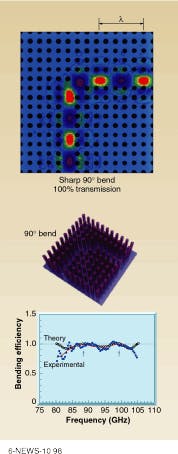Electro-optics leaders confer at Draper Lab
W. Conard Holton
The academic, industry, and government experts gathered at the Charles Stark Draper Laboratory (Cambridge, MA) on April 23-24 for the Symposium on Electro-Optics: Present and Future were more accustomed to presiding over sessions than presenting at them. Nevertheless, at the request of Vincent Vitto, president and CEO of Draper Lab, and Hermann Haus, Institute Professor at the Massachusetts Institute of Technology (MIT; Cambridge, MA), they were making presentations to and conversing with colleagues outside of their special fields. To encourage an informal exchange of ideas, attendance at the by-invitation-only meeting was limited to less than one hundred.
The symposium was billed as a chance to explore possible interactions among research areas in optics, electro-optics, micro-optics, and sensors. Haus, credited by Vitto as being the "brains and brawn behind the symposium," led off by reflecting on the origins of optoelectronic technology in microwave research, observing that the laser changed everything, bringing about the eventual dominance of optical fiber for communications.
Rod Alferness, chief technical officer for the optical networking group at Lucent Technologies (Holmdel, NJ), gave the communications theme more commercial impact by addressing the complications to come for wavelength-division multiplexing (WDM) component manufacturers. As one of the largest such manufacturers, Lucent is well acquainted with the challenges, especially the pressure for advances in modulators, attenuators, add/drop multiplexers, optical cross-connects, and multifrequency lasers.
Alferness identified the key short-term issue as the need to build these technologies for the largest number of wavelengths, adding that the current move toward 100 channels and 50-GHz spacing is just the beginning. Lowering the cost of these components is crucial to installing new systems. In the long term, semiconductor optical amplifiers, wavelength converters, switches, and ultra wideband optical amplifiers are among key components.
Erich Ippen from MIT expanded on some of the next-generation fiber devices for ultrahigh-speed optoelectronics, including research on a soliton fiber laser, optical memories, and a stretched-pulse laser. He described a high-power stretched-pulse laser built at MIT that could be a femtosecond source using only one modulator. It has been tested by Lucent as a broadband source to demonstrate 206 channels.
Materials are the future
Material research will provide the fundamental building blocks for future advances, and MIT`s John Joannopoulos enthusiastically described his team`s work on photonic bandgap crystals, which are analogous to electronic bandgap materials used to control the properties of electrons in semiconductor devices. In this material, photons cannot exist in some areas, and these gaps acts as a localization mechanism. Joannopoulos showed results of work on devices such as a channel add/drop microfilter with resonator cavity and a waveguide microcavity (see figure on p. 29).
His vision of recent materials history is noteworthy: the 1940s saw an understanding of natural materials leading to development of the transistor, the 1980s saw the mastery of artificial materials with electronic properties leading to development of the semiconductor laser, and the 1990s is witnessing the development of artificially engineered materials with photonic properties, opening up new realms such as development of a laser.
Technology leaders at the symposium also included Mara Prentiss from Harvard University (Cambridge, MA) discussing ultrahigh-resolution techniques for lithography and imaging, Ming Wu from the University of California, Los Angeles, discussing microptics; Larry Coldren from the University of California, Santa Barbara, discussing advances in vertical-cavity surface-emitting lasers; and Kristina Johnson from the University of Colorado (Boulder, CO) describing microdisplays and optical-processing systems that take advantage of liquid crystals on silicon smart-pixel devices.
Reflecting on the symposium, Draper`s Vitto says, "Since I came here from Lincoln Laboratory (Lexington, MA) nine months ago, I`ve been talking to people such as Hermann Haus about new directions. We had this conference for three reasons. We want to know what is going on in electro-optics. We want to expose people to Draper and its technologies. And we want to establish in people`s mind that Draper is interested in this technology."
Draper Laboratory has a storied past based on precision instruments and control systems for manned space flight, deep-sea technology, and strategic missile guidance. Like many laboratories with close ties to the government, Vitto says, Draper must change direction with the end of the Cold War and new priorities at NASA. Technologies such as micro-optical electromechanical devices could logically extend Draper`s capabilities in precision instrumentation. Vitto concludes, "We have a fundamental perception of optics as the future."
Theory predicts 100% transmission of light traveling around a shar¥bend through a waveguide carved out of a photonic crystal consisting of a square lattice of dielectric rods in air (top). Photonic crystal made of alumina rods of 0.2 mm diameter spaced about 1 mm apart in a square lattice pattern--designed to operate in the microwave regime--demonstrates 100% transmission of light (bottom). Transmission measurements around the shar¥bend are from Shawn Lin of Sandia National Laboratories.
